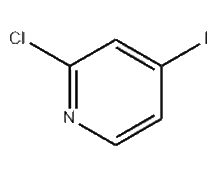When exploring chemical intermediates for organic synthesis, one compound that stands out is 2-Chloro-4-iodopyridine. With years of experience in handling halogenated pyridines, I’ve seen how this versatile molecule can simplify selective functionalization in complex synthesis. This guide covers what it is, its key properties, applications, advantages, and essential tips for buyers.
Introduction: What is 2-Chloro-4-iodopyridine?

2-Chloro-4-iodopyridine is a dihalogenated heteroaromatic compound, featuring a pyridine ring with a chlorine atom at the 2-position and an iodine atom at the 4-position. This unique substitution pattern creates a molecule with differing reactivity at the halogen sites, which is extremely useful in stepwise chemical transformations.
For new chemists, think of it as a building block that allows you to selectively introduce different functional groups onto a pyridine scaffold. Its design makes it especially valuable in pharmaceuticals, material chemistry, and fine chemical synthesis.
Key Physical and Chemical Properties
Understanding the properties of 2-Chloro-4-iodopyridine is essential for both effective reactions and safe handling:
Molecular Formula: C₅H₃ClIN
Molecular Weight: 239.44 g/mol
Structure: Pyridine ring with chlorine at 2-position and iodine at 4-position
Reactivity: Iodine is more reactive than chlorine, enabling selective cross-coupling reactions
Stability: Generally stable under standard lab conditions but should be protected from moisture and strong oxidizing agents
Its solubility in common organic solvents such as DMF, DMSO, and acetonitrile makes it highly versatile for cross-coupling and other functionalization reactions. Proper understanding of solubility and reactivity can save time and improve reaction efficiency.
Applications in Research and Industry
2-Chloro-4-iodopyridine is primarily used as an intermediate in organic synthesis:
Pharmaceutical Synthesis: Serves as a building block for heterocyclic drugs where selective functionalization of the pyridine ring is required.
Material Chemistry: Useful for constructing functionalized pyridine scaffolds in specialty materials.
Fine Chemical Synthesis: Enables stepwise introduction of functional groups via selective cross-coupling reactions, thanks to the differing reactivity of chlorine and iodine.
Its versatility comes from the ability to first react the more labile iodine site, then selectively modify the chlorine site in subsequent steps. This feature allows chemists to design more complex molecules with control and precision.
Advantages of Using 2-Chloro-4-iodopyridine
From a practical standpoint, the advantages are clear:
Selective Reactivity: Different halogen sites allow stepwise functionalization, improving synthetic flexibility.
High Efficiency: Facilitates cross-coupling reactions with predictable outcomes.
Versatility in Synthesis: Can be used for pharmaceuticals, materials, and fine chemicals.
Reliable Performance: Stable under normal lab conditions, giving consistent results when handled correctly.
In my experience, this compound reduces trial-and-error in multi-step syntheses, saving time and improving yield consistency.
Safe Handling and Storage Tips
Safety is crucial when working with halogenated pyridines:
Storage: Keep in a cool, dry place away from light and moisture. Sealed containers under inert gas are ideal for long-term storage.
Protective Measures: Use gloves, lab coat, and eye protection. Avoid direct contact.
Compatibility: Keep away from strong oxidizers and bases to prevent unwanted reactions.
Disposal: Follow local chemical waste regulations for any unused material.
Following these precautions ensures both personal safety and compound integrity for high-quality synthesis.
Is 2-Chloro-4-iodopyridine Right for Your Project?
If your project requires selective functionalization of a pyridine ring with controlled reactivity, 2-Chloro-4-iodopyridine is an excellent choice. Its combination of reactive iodine and more stable chlorine allows stepwise modifications that are widely applied in pharmaceutical and material chemistry. For new buyers, the key is understanding your synthetic goals, confirming supplier reliability, and handling the compound safely. When used correctly, it becomes a powerful tool in building complex, functionalized molecules efficiently.



